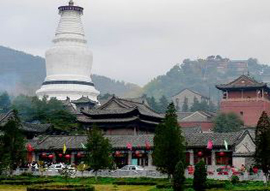Mt. Wutai, one of the sacred Buddhist mountains of China, is located in the northwest of Shanxi, with  the highest point of 3,058 meters above the sea level. Therefore it gets the name of "the roof of north China". The attractions here are numerous Buddhist temples, the most imposing structures and a huge variety of well preserved Buddhist art works including painted sculptures, frescoes and carvings. It is therefore not an exaggeration to refer the area as "a treasure house of art". the highest point of 3,058 meters above the sea level. Therefore it gets the name of "the roof of north China". The attractions here are numerous Buddhist temples, the most imposing structures and a huge variety of well preserved Buddhist art works including painted sculptures, frescoes and carvings. It is therefore not an exaggeration to refer the area as "a treasure house of art".
Mt. Wutai is believed to be the place where Manjusri lived and preached and China's only holy mountain where both Chinese Buddism and Tibetan Lamaism are practiced. The first temple was constructed as early as the Yongping period of the Eastern Han Dynasty. In later dynasties, building and repairing of the temples continued, resulting in a large complex of ancient structures. In its hey-day the mountain has over 300 temples housing more than 10,000 monks. Today, 47 of these temples are still in good condition. The oldest of all the temples preserved is Nanchan Temple which was built in the Tang Dynasty. The Buddhist statues in the main hall are vividly sculptured to those found in Mogao Grottoes in Dunhuang.
The Foguang Temple, built in the Northern Wei Dynasty, is much larger inside and more sophisticated in architectural design than the Nanchan Temple and is generally regarded as if one of the architectural gems of ancient China. Inside the magnificent hall are 530 painted clay statues in addition to the 35 placed on the altar, all from the Tang and the Ming dynasties.
According to histocial records, the Xiantong Temple is the oldest on Wutai Mountain and is also one of the first Buddhist temples ever built in China. Originally built in the year of 68 AD during the Eastern Han Dynasty, the same period as the White Horse Temple was built in Luoyang, they are both accepted as the earliest temples in China and the starting place of Chinese Buddhism. Most of the existing buildings date back to the Ming Dynasty. Especially noteworthy is the Bronze Hall with 10,000 bronze Buddha statues cast on the inside walls. It is believed that is was built in the Ming Dynasty with 50,000 kg of bronze.
Other famous temples like the Pusa Ding, Luohou Monastery, Shifang Tang, Bishan Monastery, Wanfo Ge, Jinge Monastery, Zhenhai Monastery, Shanhua Monastery, Shuxiang Monastery, Longquan Monastery, etc. all have different styles from one to another and they attract lots of pilgrims every year. |
